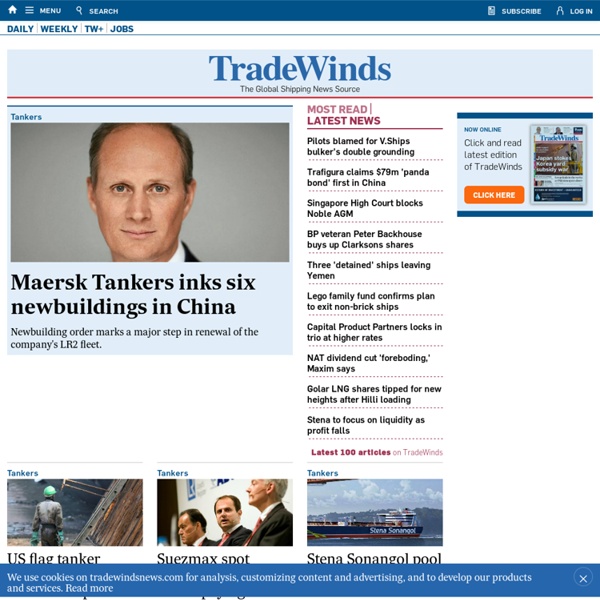



Blogs SSA Marine has been quietly moving along and has made significant strides at Long Beach Commercial shipping supremo says the West Coast must look at wider horizons Initially, such inspections were done on an ad hoc basis A look at the heartland, Great Lakes, the Seaway and inland infrastructure, too. It’s good news, bad news and a time for head scratching, too. LNG is the hot topic of the year, and will be a major focus of the 2013 SHIPPINGInsight Conference in October. Determining causes and circumstances of marine accidents in order to raise the quality of seafaring The Board of Steamboat Inspectors gets involved The GreenPort conference is likely to have a lasting impact on the Indian maritime scene. An avoidable and tragic grounding that led to safety improvements Often tenders called by major ports have conditions that weigh heavily on the bidder The only way Hong Kong is going to get all port users to burn cleaner fuel while in port is to make it a regulatory requirement.
New Time cover: New Time Department for Transport Evidence based report submitted by key stakeholders in the shipping industry about differential pay for seafarers on grounds of nationality. Published: 09 June 2010 Includes an investigation into the disappearance of the M.V. Includes information for those considering a career at sea, tonnage tax training commitment forms and the Government's response to the Freight Study Group's report into increasing freight traffic on inland waterways. Archived content The following content is available from the Department for Transport web archive . Environment- liability and compensation Help accessing downloadable file formats Most publications are available in portable document format (PDF) or rich text format (RTF) for downloading and reading offline. People with visual difficulties may find it useful to learn about improving the accessibility of Acrobat documents at the Adobe Accessibility Resource Centre . For information about RTF and zip files please visit help with downloads .
IDAG.NO - Norway TODAY Solar-powered Ship EmailEmail Nippon Yusen KK and Nippon Oil Corp are working on the world’s first solar powered ship … well, at least partially solar powered, they are saying. What? The ship will carry Toyota cars. Fuel savings are expected to be in the neighborhood of 6.5% and carbon dioxide emissions will be reduced by 1-2% or 20 tons per year. The ship is expected to be completed by December with damage to the panels from salt and vibration the biggest obstacles. A Nippon Oil dude says, “If it’s possible, we want to aim for the full commercialization of the system in the next three to five years.”
Freedom Ship National Atmospheric Emissions Inventory This section of the website contains all the published NAEI reports. The "Other important reports" section contains links to useful reports that are on this website. Search for reports by keywords, author or date » Most Recent 10 Reports 1. UK Emission Mapping Methodology 2009 (PDF) This report has been superseded by a newer version. View full report details 2. View full report details 3. View full report details 4. View full report details 5. View full report details 6. View full report details 7. View full report details 8. Please note that there has been a change of format between 2009 and 2011 version – the new version provides a summary of the latest air quality pollutant inventory data and focuses on the key pollutants subject to reduction targets under the Gothenburg Protocol and the EU National Emissions Ceilings Directive. View full report details 9. View full report details 10. View full report details
Wikipedia: Environmental impact of shipping A cargo ship discharging ballast water into the sea. The environmental impact of shipping includes greenhouse gas emissions, acoustic, and oil pollution. Carbon dioxide emissions from shipping is estimated to be 4 to 5 percent of the global total, and estimated by the International Maritime Organization (IMO) to rise by as much as 72 percent by 2020 if no action is taken.[1] The First Intersessional Meeting of the IMO Working Group on Greenhouse Gas Emissions[2] from Ships took place in Oslo, Norway on 23–27 June 2008. Ballast water[edit] Ballast water discharges by ships can have a negative impact on the marine environment. Cruise ships, large tankers, and bulk cargo carriers use a huge amount of ballast water, which is often taken on in the coastal waters in one region after ships discharge wastewater or unload cargo, and discharged at the next port of call, wherever more cargo is loaded. Sound pollution[edit] Ship impacts[edit] Exhaust emissions[edit] Cruise ship haze over Juneau, Alaska
Operational discharge - Detecting illegal discharge Visual aerial detection. Remote sensing. Tools of the future. Background In order for a case of illegal discharge of hydrocarbons at sea to lead to legal action, the offender must be clearly identified. Legal action can be taken by the coastal State if the offence takes place in its territorial waters, its exclusive economic zone, or indeed in its marine protected area. To establish the liability of a vessel suspected of pollution, it must be proven that the discharge came from the vessel in question, and a much evidence as possible must be gathered on the nature and extent of the pollution. Detection means Visual aerial detection Aerial observation is the main tool used to detect operational pollution by ships. Visual observation of slicks in the wake of ships from aircraft, together with colour photographs, constitutes the first element used to establish the existence of discharged pollutant. Bonn Agreement appearance code. Remote sensing Tools of the future Last update: December 2008